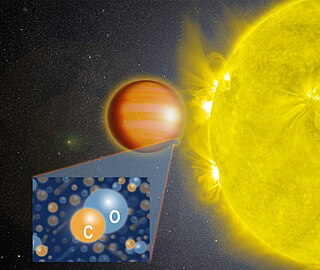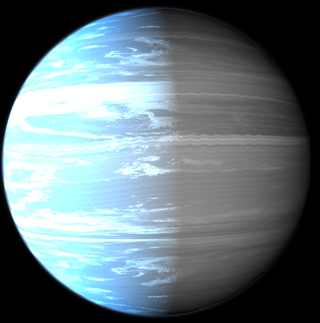
The study of extraterrestrial atmospheres is an active field of research, both as an aspect of astronomy and to gain insight into Earth's atmosphere. In addition to Earth, many of the other astronomical objects in the Solar System have atmospheres. These include all the gas giants, as well as Mars, Venus and Titan. Several moons and other bodies also have atmospheres, as do comets and the Sun. There is evidence that extrasolar planets can have an atmosphere. Comparisons of these atmospheres to one another and to Earth's atmosphere broaden our basic understanding of atmospheric processes such as the greenhouse effect, aerosol and cloud physics, and atmospheric chemistry and dynamics.

HD 189733 b is an exoplanet in the constellation of Vulpecula approximately 64.5 light-years away from our Solar System. Astronomers in France discovered the planet orbiting the star HD 189733 on October 5, 2005, by observing its transit across the star's face. With a mass 11.2% higher than that of Jupiter and a radius 11.4% greater, HD 189733 b orbits its host star once every 2.2 days at an orbital speed of 152.0 kilometers per second, making it a hot Jupiter with poor prospects for extraterrestrial life.

WASP-4b is an exoplanet, specifically a hot Jupiter, approximately 891 light-years away in the constellation of Phoenix.

WASP-6b, also named Boinayel, is an exoplanet approximately 650 light years away in the constellation Aquarius. It was discovered in 2008, by the WASP survey, by astronomical transit across its parent star WASP-6. This planet orbits at only 4% of the Earth-Sun distance. The planet has a mass half that of Jupiter, but its insolation has forced a thermal expansion of its radius to greater than that of Jupiter. Thus, this planet is an inflated hot Jupiter. Starspots on the host star WASP-6 helped to refine the measurements of the mass and the radius of the planet.

WASP-17b is an exoplanet in the constellation Scorpius that is orbiting the star WASP-17. Its discovery was announced on 11 August 2009. It is the first planet discovered to have a retrograde orbit, meaning it orbits in a direction counter to the rotation of its host star. This discovery challenged traditional planetary formation theory. In terms of diameter, WASP-17b is one of the largest exoplanets discovered and at half Jupiter's mass, this made it the most puffy planet known in 2010. On 3 December 2013, scientists working with the Hubble Space Telescope reported detecting water in the exoplanet's atmosphere.

WASP-18b is an exoplanet that is notable for having an orbital period of less than one day. It has a mass equal to 10 Jupiter masses, just below the boundary line between planets and brown dwarfs. Due to tidal deceleration, it is expected to spiral toward and eventually merge with its host star, WASP-18, in less than a million years. The planet is approximately 3.1 million km from its star, which is about 400 light-years from Earth. A team led by Coel Hellier, a professor of astrophysics at Keele University in England, discovered the exoplanet in 2009.
WASP-18 is a magnitude 9 star located 400 light-years away in the Phoenix constellation of the southern hemisphere. It has a mass of 1.29 solar masses.

WASP-19b, formally named Banksia, is an exoplanet, notable for possessing one of the shortest orbital periods of any known planetary body: 0.7888399 days or approximately 18.932 hours. It has a mass close to that of Jupiter, but by comparison has a much larger radius ; making it nearly the size of a low-mass star. It orbits the star WASP-19 in the Vela constellation. At the time of discovery it was the shortest period hot Jupiter discovered as planets with shorter orbital periods had a rocky, or metallic composition.

WASP-43b, formally named Astrolábos, is a transiting planet in orbit around the young, active, and low-mass star WASP-43 in the constellation Sextans. The planet is a hot Jupiter with a mass twice that of Jupiter, but with a roughly equal radius. WASP-43b was flagged as a candidate by the SuperWASP program, before they conducted follow-ups using instruments at La Silla Observatory in Chile, which confirmed its existence and provided orbital and physical characteristics. The planet's discovery was published on April 14, 2011.

TRAPPIST-1b, also designated as 2MASS J23062928-0502285 b, is a mainly rocky exoplanet orbiting around the ultra-cool dwarf star TRAPPIST-1, located 40.7 light-years away from Earth in the constellation of Aquarius. The planet was detected using the transit method, where a planet dims the host star's light as it passes in front of it. It was first announced on May 2, 2016, and later studies were able to refine its physical parameters.

TRAPPIST-1c, also designated as 2MASS J23062928-0502285 c, is a mainly rocky exoplanet orbiting around the ultracool dwarf star TRAPPIST-1, located 40.7 light-years away from Earth in the constellation Aquarius. It is the third most massive and third largest planet of the system, with about 131% the mass and 110% the radius of Earth. Its density indicates a primarily rocky composition, and observations by the James Webb Space Telescope announced in 2023 suggests against a thick CO2 atmosphere, however this does not exclude a thick abiotic oxygen-dominated atmosphere as is hypothesized to be common around red dwarf stars.

WASP-121b, formally named Tylos, is an exoplanet orbiting the star WASP-121. WASP-121b is the first exoplanet found to contain water in an extrasolar planetary stratosphere. WASP-121b is in the constellation Puppis, and is about 858 light-years from Earth.
WASP-121, also known as CD-38 3220, is a magnitude 10.4 star located approximately 858 light-years away in the constellation Puppis. WASP-121 has a mass and radius similar to the Sun's. It hosts one known exoplanet.

WASP-39b, officially named Bocaprins, is a "hot Jupiter" extrasolar planet discovered in February 2011 by the WASP project, notable for containing a substantial amount of water in its atmosphere. In addition WASP-39b was the first exoplanet found to contain carbon dioxide in its atmosphere, and likewise for sulfur dioxide.

HIP 65426 b, formally named Najsakopajk, is a super-Jupiter exoplanet orbiting the star HIP 65426. It was discovered on 6 July 2017 by the SPHERE consortium using the Spectro-Polarimetric High-Contrast Exoplanet Research (SPHERE) instrument belonging to the European Southern Observatory (ESO). It is 385 light-years from Earth. It is the first planet discovered by ESO's SPHERE instrument.

WASP-76b is an exoplanet classified as a Hot Jupiter. It is located in the constellation Pisces and orbits its host star, WASP-76, at a distance of approximately 0.033 astronomical units (AU). The orbital period of WASP-76b is approximately 1.8 days. Its mass is about 0.92 times that of Jupiter. The discovery of WASP-76b took place on October 21, 2013, and it is currently the only known planet in the WASP-76 system as of 2022. The equilibrium temperature of WASP-76b is estimated to be around 2,190 K, However, the measured daytime temperature is higher, reaching approximately 2,500 ± 200 K.
WASP-62, formally named Naledi, is a single star about 573 light-years away. It is an F class main-sequence star, orbited by a planet, WASP-62b. The age of WASP-62 is much younger than the Sun at 0.8±0.6 billion years, and it has a metal abundance similar to the Sun.
WASP-80 is a K-type main-sequence star about 162 light-years away. The star's age is much younger than the Sun's at 1.352±0.222 billion years. WASP-80 is similar to the Sun in concentration of heavy elements, although this measurement is highly uncertain.
WASP-96 is a G8-type star, located approximately 1140 light-years from Earth in the constellation of Phoenix.














